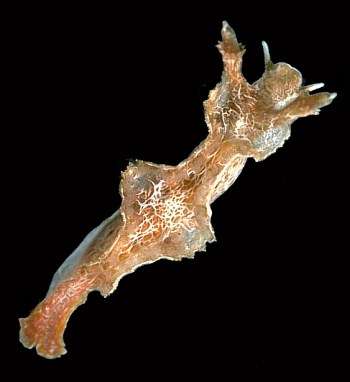
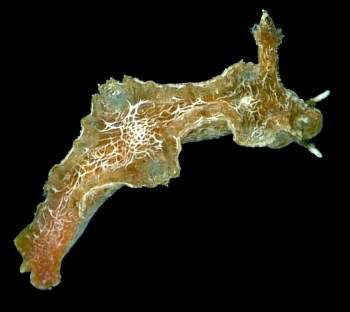
Lomanotus sp. 1.
Order: NUDIBRANCHIA
Suborder: DENDRONOTINA
Family: Lomanotidae
DISTRIBUTION
Tropical western Pacific.
PHOTO
Lagoon between mainland and Récif de l'Infernet, off Koumac, New Caledonia, 20°34.4'S, 164°13'E, 12m, Silty bottom with dense gorgonian beds, on hydroids, October 1993, 17mm long alive. PHOTO: Bill Rudman.
Garcia Gomez et al (1990) recognise five species of Lomanotus. L. genei with 2 pairs of oral tentacles & L. marmoratus with 3 pairs (both widespread in western Europe); L. barlettai from Atlantic Spain, L. phiops from Brazil and L. vermiformis from the tropical Indo-west Pacific, eastern Pacific and western Atlantic, all with a single pair of oral tentacles. Lomanotus sp. 1, also with a single pair of oral tentacles, has large mantle lobes and prominent papillae restricted to the lobes, which is quite different from the only described species in the Indo-West Pacific, L. vermiformis.
References:
•Clark, K.B. & Goetzfried, A, (1976). Lomanotus stauberi, a new dendronotacean nudibranch from central Florida (Mollusca: Opisthobranchia). Bulletin of Marine Science, 26(4): 474-478.
•Garcia-Gomez, J.C. & Lopez-Gonzalez, P.J., Garcia, F.J, (1990). Lomanotus barlettai, a new species of nudibranch mollusk from the Iberian littoral, with remarks on world species of the genus. Canadian Journal of Zoology, 68: 2299-2305.
•Gosliner, T.M, & Bertsch, H, (1985). Records and morphology of Lomanotus stauberi Clark & Goetzfried, 1976, from the Panamic Pacific. The Veliger 27(4): 397-405.
•Marcus, Er. (1957). On Opisthobranchia from Brazil (2). Journal of the Linnean Society of London, Zoology 43: 390-486.
•Willan, R.C, (1988). The taxonomy of two host-specific, cryptic dendronotoid nudibranch species (Mollusca: Gastropoda) from Australia including a new species description. Zoological Journal of the Linnean Society, 94: 39-63.
Rudman, W.B., 1999 (October 13) Lomanotus sp. 1. [In] Sea Slug Forum. Australian Museum, Sydney. Available from http://www.seaslugforum.net/find/lomasp1
Related messages
Re: One or two species of Lomanotus from Indonesia
May 5, 2010
From: Sandra Millen
Concerning message #23343:
Hi Bill and Kevin,
I collected one just like your top photo in the Philippines. Quite large compared to most. Mike Miller has it on the slug site.
Sandra Millen
millen@zoology.ubc.ca
Millen, S., 2010 (May 5) Re: One or two species of Lomanotus from Indonesia. [Message in] Sea Slug Forum. Australian Museum, Sydney. Available from http://www.seaslugforum.net/find/23578One or two species of Lomanotus from Indonesia
April 25, 2010
From: Kevin Lee
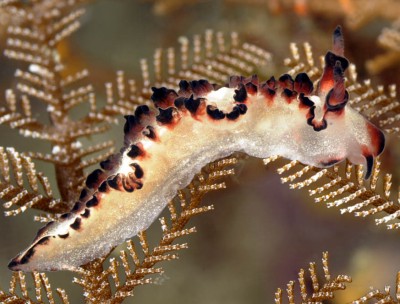
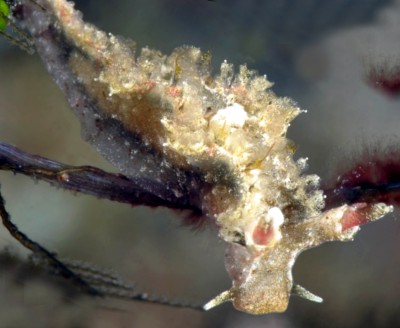
A few months ago, I was fortunate to dive in Raja Ampat, Indonesia, where I bumped into about 90 slug species. Among them were various flavors of Lomanotus, found normally on hydroids during night dives. Here are a few examples.
Locality: Raja Ampat, 20-35 feet, Indonesia, Indo-Pacific, December 2009, rock reefs. Length: < 0.5 inch. Photographer: Kevin Lee.
Best regards,
K:-)
diverkevin@gmail.com
Kevin Lee, 2010 (Apr 25) One or two species of Lomanotus from Indonesia. [Message in] Sea Slug Forum. Australian Museum, Sydney. Available from http://www.seaslugforum.net/find/23343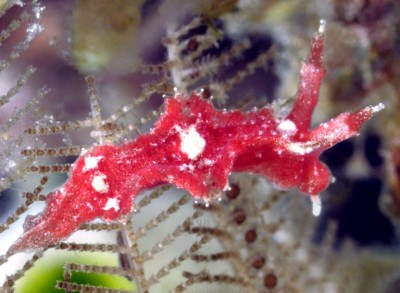
Dear Kevin,
I am not sure how many species you have here. I am including them all under Lomanotus sp. 1 but I think we need to look at the anatomy of these different coloured 'forms' before we can get a better idea concerning the importance of colour in this group.
Best wishes,
Bill Rudman
Re: Lomanotus from the Philippines
July 11, 2008
From: Jim Anderson
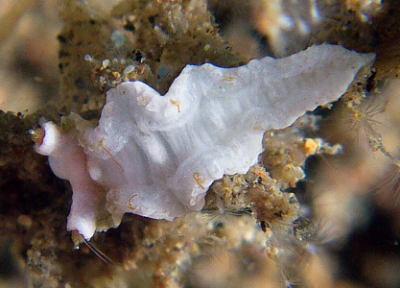
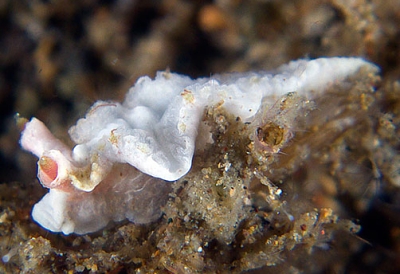
Concerning message #10797:
Bill,
You may be interested in the attached.
This part of the world is remarkably rich in nudibranch fauna. See my site at www.pinoyseaslugs.com for the animals recently seen during 3 weeks of diving.
Locality: Secret Bay, Batangas, Luzon, 14 m, Philippines, W. Pacific, 5 May 2008, On hydroid on gravel slope. Length: 20 mm. Photographer: Jim Anderson.
Jim Anderson.
jander4454@gmail.com
Anderson, J, 2008 (Jul 11) Re: Lomanotus from the Philippines. [Message in] Sea Slug Forum. Australian Museum, Sydney. Available from http://www.seaslugforum.net/find/21689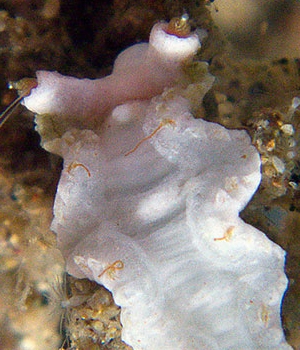
Dear Jim,
Thanks for the photos. Yes the Philippines-Indonesian region is particularly rich - lets hope the local people's desire for food and a better life, and the developed world's insatiable desire to put pretty fish etc in aquaria doesn't destroy it.
I am particularly interested in the little orange threads on the edge of the mantle. At first I thought they were debris caught on the mantle but they are so regularly arranged that they must be part of the animal. Perhaps little gills? Some species do have small gill-like branches but usually they are transparent and almost invisible.
Best wishes,
Bill Rudman
Re: Lomanotus from the Philippines
July 8, 2008
From: Erwin Köhler
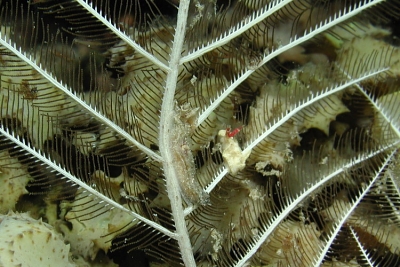
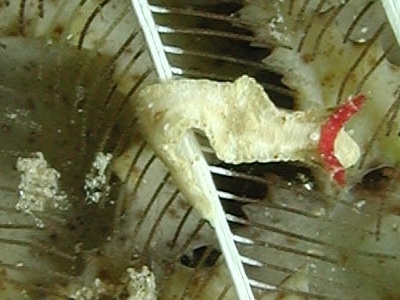
Concerning message #10762:
Dear Bill,
Here is the same specimen in the above message together with a red rhinopore-one, same nightdive (Philippines, Cabilao island, divesite "Lighthouse"). Data of the red rhinophore animals: length 14 mm, depth 5 m,
26 Feb. 2003
Erwin
Erwin@Philippine-Sea-Slugs.com
Koehler, E., 2008 (Jul 8) Re: Lomanotus from the Philippines. [Message in] Sea Slug Forum. Australian Museum, Sydney. Available from http://www.seaslugforum.net/find/10797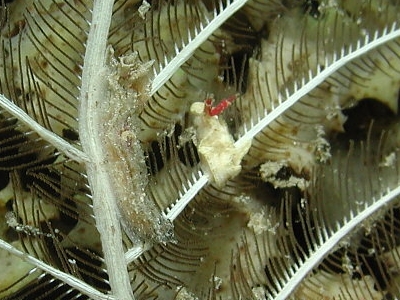
Dear Erwin,
It's possible the red-rhinophore animal is a separate species but at this stage I suspect it is a juvenile colour form of Lomanotus sp. 1. It has traces of the lobes found in that species and both you and Scott Johnson [see message #1420] have found large Lomanotus sp. 1 and small 'red-rhinophore' together. The large animal in your earlier message [#10796 ] has a pale reddish band across the head which could indicate it fades as the animal matures.
Best wishes
Bill Rudman
Re: Lomanotus from the Philippines
July 8, 2008
From: Erwin Köhler

Concerning message #10762:
Dear Bill,
Here is an other specimen, same nightdive. It shows white oral tentacles.
data: Cabilao island, divesite "Lighthouse", nightdive. I saw them always upon this kind of hydroid. Length 24 mm, Depth 5 m. 26 Feb. 2003
Erwin
Erwin@Philippine-Sea-Slugs.com
Koehler, E., 2008 (Jul 8) Re: Lomanotus from the Philippines. [Message in] Sea Slug Forum. Australian Museum, Sydney. Available from http://www.seaslugforum.net/find/10796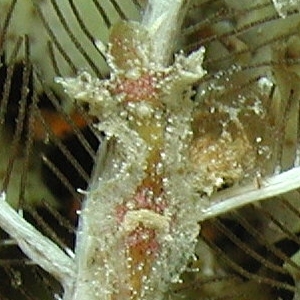
Dear Erwin,
While preparing Brian Francisco's message on Lomanotus [#21680] I discovered this message and its partner [#10797] which have been languishing unnoticed and unpublished since 2003. I'm very sorry about that, but at times I become so overwhelmed with messages that some get lost in storage. The good side is that they are never actually lost, just in a state of 'suspended animation'.
This is clearly not Lomanotus vermiformis. Without looking at its anatomy I can't be sure, but I suspect it is what I have been calling Lomanotus sp. 1. It doesn't have the white reticulate pattern, but I suspect that is a variable feature. The other possibility is that there could be more than one lobed species. Interestingly it has a pinkish patch on the head which could be a link to the red band found in small specimens. I am pretty sure the hydroid is an aglaophenid.
Best wishes
Bill Rudman
Rudman, W.B., 2008 (Jul 8). Comment on Re: Lomanotus from the Philippines by Erwin Köhler. [Message in] Sea Slug Forum. Australian Museum, Sydney. Available from http://www.seaslugforum.net/find/10796
Lomanotus sp. 1 from East Timor
July 8, 2008
From: Brian Francisco
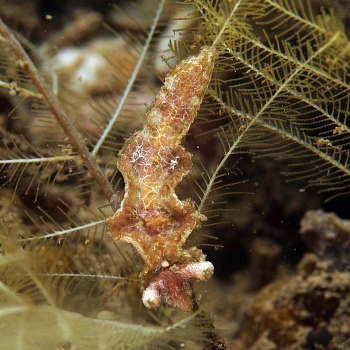
Concerning message #21668:
Hi Bill
We have one more for you. It's one of the more bizzare nudibranchs we've found here in East Timor. We appreciate your help.
Locality: Dili Rock, 14 metres, East Timor, Banda Sea, 9 March 2008, coral reef. Length: 1 cm. Photographer: Brian Francisco.
Regards
Brian
www.uwet.net
francisco.brian@gmail.com
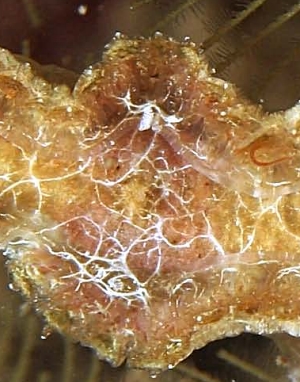
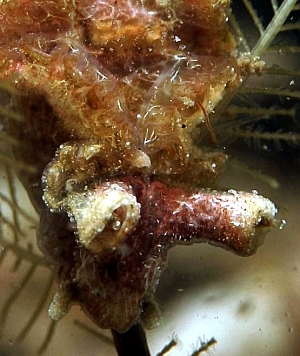
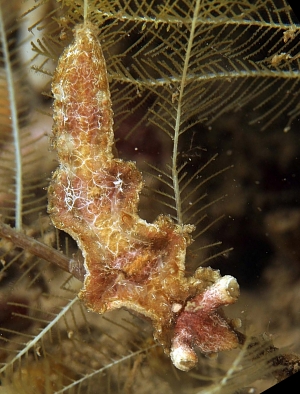
Dear Brian,
Thanks for this interesting find. It is the species I have called Lomanotus sp. 1 which can be easily distinguished from the other Pacific species, Lomanotus vermiformis, by its lobed body and elaborate pattern on the back. I presume the hydroid it is on is an aglaopheniid [a family of stinging hydroids] which seem to be the food preference of this group. While preparing your message I discovered two unpublished messages from Erwin Koehler which unfortunately escaped my notice in 2003 [#10796, #10797]. So I'll take this opportunity to post them as well as they seem to suggest this species starts life with a red band across its head.
I have included a close-up across the back to show the strange tracery of lines, ducts and branching gills which are very reminiscent of some members of the Scyllaeidae, such as Notobryon.
Best wishes,
Bill Rudman
Lomanotus from the Philippines
August 20, 2003
From: Erwin Köhler
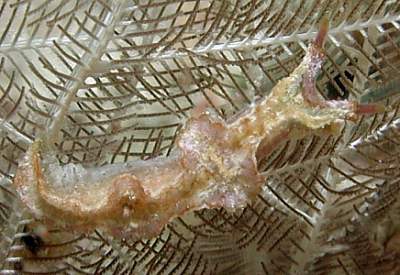
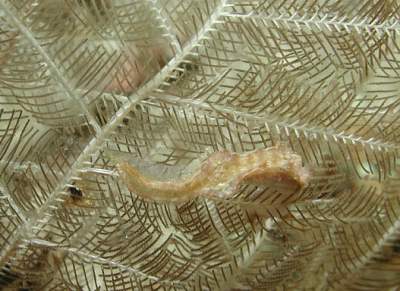
Dear Bill,
Here are 2 shots of a "tritoniid" from the Philippines.
Cabilao island, divesite "Lighthouse", nightdive. I saw them always upon this kind of hydroid.
length 19mm
depth 7m
date 26 Feb. 2003
Cheers,
Erwin
Erwin@Philippine-Sea-Slugs.com
Köhler, E., 2003 (Aug 20) Lomanotus from the Philippines. [Message in] Sea Slug Forum. Australian Museum, Sydney. Available from http://www.seaslugforum.net/find/10762Dear Erwin,
I think this is the species of Lomanotus I am calling Lomanotus sp.1. It would be useful to know what the head looks like for confirmation. I need to see whether it has a pair of oral tentacles or not
Best wishes,
Bill Rudman
Another Lomanotus from western Pacific
October 14, 1999
From: Scott Johnson
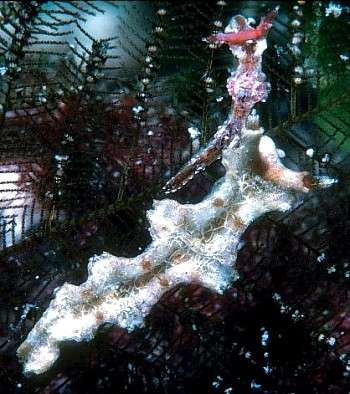
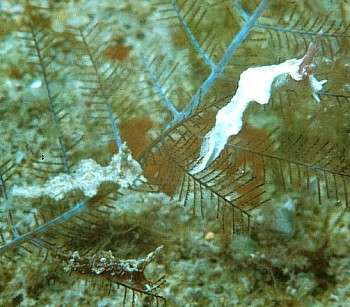
Hi Bill,
I have this one tentatively identified as Eumenis marmorata Alder & Hancock, 1846. The animals are extremely variable in coloration. I've found them on two occasions, and both times there were several individuals, no two of them alike in color. My specimens ranged from about 5 to 10 mm in length, and they are shown here on what is apparently their prey hydroid. They are rare here in the Marshalls, but I've found one group at both Kwajalein and Enewetak Atolls.
Scott
johnson@kmr.ll.mit.edu
Johnson, S., 1999 (Oct 14) Another Lomanotus from western Pacific. [Message in] Sea Slug Forum. Australian Museum, Sydney. Available from http://www.seaslugforum.net/find/1420This definitely a species of Lomanotus (=Eumenis). L. marmoratus has quite prominent papillae or cerata all along the mantle edge. It also has two pairs of oral (head) tentacles, and is found along the Atlantic coast of Europe.
I have found this species in New Caledonia. My photos of an animal from there, show that this species has only one pair of tentacles and the papillae are on the whole restricted to the mantle lobes. Unless there is a name lurking around in some forgotten publication I think this species has not been named.
Bill Rudman.
Rudman, W.B., 1999 (Oct 14). Comment on Another Lomanotus from western Pacific by Scott Johnson. [Message in] Sea Slug Forum. Australian Museum, Sydney. Available from http://www.seaslugforum.net/find/1420